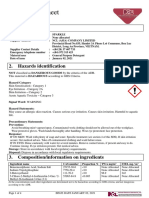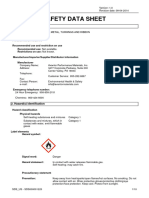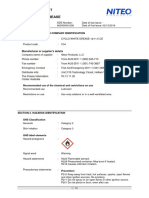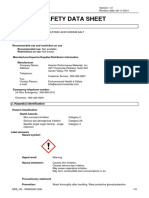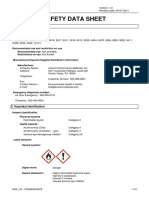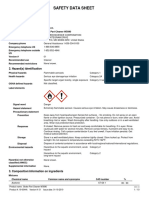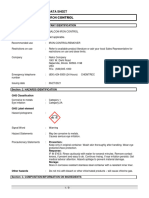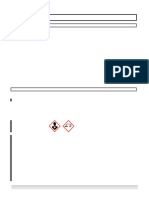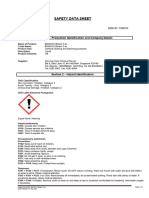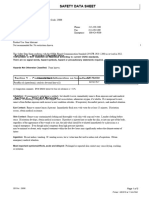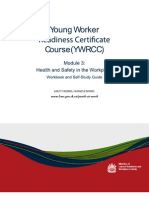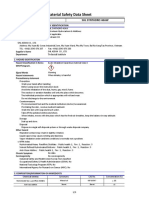Flozol 2252D (SDS)
Flozol 2252D (SDS)
Uploaded by
marianaCopyright:
Available Formats
Flozol 2252D (SDS)
Flozol 2252D (SDS)
Uploaded by
marianaOriginal Description:
Original Title
Copyright
Available Formats
Share this document
Did you find this document useful?
Is this content inappropriate?
Copyright:
Available Formats
Flozol 2252D (SDS)
Flozol 2252D (SDS)
Uploaded by
marianaCopyright:
Available Formats
Version: 1.
1
Revision Date: 06/02/2015
SAFETY DATA SHEET
1. Identification
Identification
Product name: FLOZOL® 2252D
Additional identification
Chemical name: Formaldehyde, polymers with phenol
Recommended use and restriction on use
Recommended use: Not determined.
Restrictions on use: Not determined.
Details of the supplier of the safety data sheet
Supplier
Company Name: THE LUBRIZOL CORPORATION
Address: 29400 LAKELAND BOULEVARD
WICKLIFFE, OH 44092-2298
US
Telephone: (440)943-1200
Emergency telephone number:
FOR TRANSPORT EMERGENCY CALL CHEMTREC (+1)703 527 3887, OR WITHIN USA 800 424 9300
(LUBRIZOL)
2. Hazard(s) identification
Hazard Classification
Physical Hazards
Flammable liquids Category 4
Health Hazards
Serious Eye Damage/Eye Category 2A
Irritation
Unknown toxicity
Acute toxicity, oral 57.6 %
Acute toxicity, dermal 0.0 %
Acute toxicity, inhalation, vapor 100.0 %
Acute toxicity, inhalation, dust 57.6 %
or mist
Label Elements:
Hazard Symbol:
Signal Word: Warning
Hazard Statement: Combustible liquid.
Causes serious eye irritation.
SDS_US - FLOZOL® 2252D 1/10
Version: 1.1
Revision Date: 06/02/2015
Precautionary Statement:
Prevention: Keep away from heat, hot surfaces, sparks, open flames and
other ignition sources. No smoking. Wear protective
gloves/protective clothing/eye protection/face protection. Wash
thoroughly after handling. Avoid release to the environment.
Response: If in eyes: Rinse cautiously with water for several minutes.
Remove contact lenses, if present and easy to do. Continue
rinsing. If eye irritation persists: Get medical advice/attention. In
case of fire: Use CO2, dry chemical or foam for extinction.
Water can be used to cool and protect exposed material.
Storage: Store in well-ventilated place. Keep cool.
Disposal: Dispose of contents/container to an appropriate treatment and
disposal facility in accordance with applicable laws and
regulations, and product characteristics at time of disposal.
Other hazards which do not result None identified.
in GHS classification:
3. Composition/information on ingredients
General information:
Chemical name CAS number Percent by Weight
Formaldehyde, polymers with phenol Not determined. 50 - 60%
Petroleum naphtha 64742-47-8 40 - 50%
4. First-aid measures
Ingestion: Rinse mouth. Get medical attention if symptoms occur.
Inhalation: Remove exposed person to fresh air if adverse effects are observed.
Skin Contact: Take off contaminated clothing and wash before re-use. Wash with soap
and water. If skin irritation occurs, get medical attention.
Eye contact: Rinse cautiously with water for several minutes. Remove contact lenses, if
present and easy to do. Continue rinsing. If eye irritation persists: Get
medical advice/attention.
Most important symptoms/effects, acute and delayed
Symptoms: See section 11.
Indication of immediate medical attention and special treatment needed
Treatment: Treat symptomatically.
5. Fire-fighting measures
General Fire Hazards: Move containers from fire area if you can do so without risk.
SDS_US - FLOZOL® 2252D 2/10
Version: 1.1
Revision Date: 06/02/2015
Suitable (and unsuitable) extinguishing media
Suitable extinguishing CO2, Dry chemical or Foam. Water can be used to cool and protect
media: exposed material.
Unsuitable extinguishing Do not use water jet as an extinguisher, as this will spread the fire.
media:
Specific hazards arising from Vapors may cause a flash fire or ignite explosively. Prevent buildup of
the chemical: vapors or gases to explosive concentrations. Vapors may travel
considerable distance to a source of ignition and flash back. Water may
cause splattering. Container may rupture on heating. A solid stream of
water will spread the burning material. Material creates a special hazard
because it floats on water. See section 10 for additional information.
Special protective equipment and precautions for firefighters
Special fire fighting No data available.
procedures:
Special protective Firefighters must use standard protective equipment including flame
equipment for fire-fighters: retardant coat, helmet with face shield, gloves, rubber boots, and in
enclosed spaces, SCBA.
6. Accidental release measures
Personal precautions, ELIMINATE all ignition sources (no smoking, flares, sparks or flames in
protective equipment and immediate area). Ventilate area if spilled in confined space or other poorly
emergency procedures: ventilated areas. Personal Protective Equipment must be worn, see
Personal Protection Section for PPE recommendations.
Methods and material for Eliminate all ignition sources if safe to do so. Dike far ahead of larger spill
containment and cleaning up: for later recovery and disposal. Pick up free liquid for recycle and/or
disposal. Residual liquid can be absorbed on inert material. Stop the flow of
material, if this is without risk. Prevent entry into waterways, sewer,
basements or confined areas.
Environmental Precautions: Do not contaminate water sources or sewer. Prevent further leakage or
spillage if safe to do so.
7. Handling and storage
Precautions for safe handling: Keep away from heat, hot surfaces, sparks, open flames and other ignition
sources. No smoking. Avoid contact with eyes. Observe good industrial
hygiene practices. Provide adequate ventilation. Wear appropriate personal
protective equipment. Wash hands thoroughly after handling.
Maximum Handling Not determined.
Temperature:
Conditions for safe storage, Keep cool. Store in a well-ventilated place. Do not store near potential
including any sources of ignition.
incompatibilities:
Maximum Storage Not determined.
Temperature:
SDS_US - FLOZOL® 2252D 3/10
Version: 1.1
Revision Date: 06/02/2015
8. Exposure controls/personal protection
Control Parameters:
Occupational Exposure Limits
Chemical name type Exposure Limit Values Source
Petroleum naphtha - Non- TWA 200 mg/m3 US. ACGIH Threshold Limit Values (02 2012)
aerosol. - as total
hydrocarbon vapor
Petroleum naphtha REL 100 mg/m3 US. NIOSH: Pocket Guide to Chemical
Hazards (2010)
Appropriate engineering Adequate ventilation should be provided so that exposure limits are not
controls: exceeded. Mechanical ventilation or local exhaust ventilation may be
required.
Individual protection measures, such as personal protective equipment
General information: Provide easy access to water supply and eye wash facilities. Good general
ventilation (typically 10 air changes per hour) should be used. Ventilation
rates should be matched to conditions. If applicable, use process
enclosures, local exhaust ventilation, or other engineering controls to
maintain airborne levels below recommended exposure limits. If exposure
limits have not been established, maintain airborne levels to an acceptable
level.
Eye/face protection: Safety glasses. If potential for splash or mist exists, wear chemical goggles
or faceshield.
Skin Protection
Hand Protection: Use nitrile or neoprene gloves. Use good industrial hygiene practices. In
case of skin contact, wash hands and arms with soap and water.
Other: Wear apron or protective clothing in case of contact.
Respiratory Protection: A respiratory protection program compliant with all applicable regulations
must be followed whenever workplace conditions require the use of a
respirator. Under normal use conditions, respirator is not usually required.
Use appropriate respiratory protection if exposure to dust particles, mist or
vapors is likely. Use self-contained breathing apparatus for entry into
confined space, for other poorly ventilated areas and for large spill clean-up
sites.
Hygiene measures: Observe good industrial hygiene practices. Avoid contact with eyes. When
using do not smoke.
9. Physical and chemical properties
Appearance
Physical state: liquid
Form: liquid
Color: Dark
Odor: Mild
Odor threshold: No data available.
pH: No data available.
Freezing point: No data available.
Boiling Point: No data available.
Flash Point: 153 °F (67 °C) (Pensky-Martens Closed Cup)
SDS_US - FLOZOL® 2252D 4/10
Version: 1.1
Revision Date: 06/02/2015
Evaporation rate: No data available.
Flammability (solid, gas): No data available.
Upper/lower limit on flammability or explosive limits
Flammability limit - upper (%): No data available.
Flammability limit - lower (%): No data available.
Explosive limit - upper (%): No data available.
Explosive limit - lower (%): No data available.
Vapor pressure: No data available.
Vapor density: No data available.
Relative density: 0.87 60.1 °F (15.6 °C)
Solubility(ies)
Solubility in water: Insoluble in water
Solubility (other): No data available.
Partition coefficient (n-octanol/water): No data available.
Auto-ignition temperature: No data available.
Decomposition temperature: No data available.
Viscosity: 90 mm2/s ( 104 °F (40 °C) )
10. Stability and reactivity
Reactivity: No data available.
Chemical Stability: Material is stable under normal conditions.
Possibility of Hazardous Will not occur.
Reactions:
Conditions to Avoid: Heat, sparks, flames.
Incompatible Materials: Strong oxidizing agents.
Hazardous Decomposition Thermal decomposition or combustion may generate smoke, carbon
Products: monoxide, carbon dioxide, and other products of incomplete combustion.
11. Toxicological information
Information on likely routes of exposure
Inhalation: No data available.
Ingestion: No data available.
Skin Contact: No data available.
Eye contact: Causes serious eye irritation.
Information on toxicological effects
Acute toxicity
Oral
Product: Swallowing material may cause irritation of the gastrointestinal
lining, nausea, vomiting, diarrhea, and abdominal pain. Ingestion
can cause central nervous system effects such as headache,
dizziness, drowsiness, and generalized weakness.
Not classified for acute toxicity based on available data.
SDS_US - FLOZOL® 2252D 5/10
Version: 1.1
Revision Date: 06/02/2015
Dermal
Product: Not classified for acute toxicity based on available data.
Inhalation
Product: High concentrations may cause headaches, dizziness, nausea,
behavioral changes, weakness, drowsiness and stupor.
Not classified for acute toxicity based on available data.
Skin Corrosion/Irritation:
Product: Prolonged or repeated skin contact as from clothing wet with
material may cause dermatitis. Symptoms may include redness,
edema, drying, and cracking of the skin.
Remarks: Not classified as a primary skin irritant.
Serious Eye Damage/Eye Irritation:
Product: Remarks: Causes serious eye irritation.
Respiratory sensitization:
No data available
Skin sensitization:
Petroleum naphtha Classification: Not a skin sensitizer. (Literature)
Specific Target Organ Toxicity - Single Exposure:
Petroleum naphtha If material is misted or if vapors are generated from heating,
exposure may cause irritation of mucous membranes and the upper
respiratory tract.
Aspiration Hazard:
Petroleum naphtha Material can be aspirated into the lungs during the act of swallowing
or vomiting. This could result in severe injury to the lungs and death.
Chronic Effects
Carcinogenicity:
No data available
IARC Monographs on the Evaluation of Carcinogenic Risks to Humans:
No carcinogenic components identified
US. National Toxicology Program (NTP) Report on Carcinogens:
No carcinogenic components identified
US. OSHA Specifically Regulated Substances (29 CFR 1910.1001-1050):
No carcinogenic components identified
Germ Cell Mutagenicity:
Petroleum naphtha In vitro and in vivo genetic toxicity studies were negative.
Reproductive toxicity:
No data available
Specific Target Organ Toxicity - Repeated Exposure:
Petroleum naphtha Repeated overexposure to petroleum naphtha can cause nervous
SDS_US - FLOZOL® 2252D 6/10
Version: 1.1
Revision Date: 06/02/2015
system damage.
12. Ecological information
Ecotoxicity
Fish
Formaldehyde, polymers with LC 50 (Rainbow Trout, 96 h): 33.24 mg/l
phenol
Petroleum naphtha LC 50 (Rainbow Trout, 4 d): > 1,000 mg/l
Aquatic Invertebrates
Petroleum naphtha EC 50 (Water flea (Daphnia magna), 2 d): > 1,000 mg/l
Toxicity to Aquatic Plants
Petroleum naphtha EC 50 (Green algae (Selenastrum capricornutum), 3 d): > 1,000
mg/l
LC 50 (Green algae (Selenastrum capricornutum), 3 d): > 1,000 mg/l
Toxicity to soil dwelling organisms
No data available
Sediment Toxicity
No data available
Toxicity to Terrestrial Plants
No data available
Toxicity to Above-Ground Organisms
No data available
Toxicity to microorganisms
Formaldehyde, polymers with EC 50 (Sludge, 3 h): > 1,000 mg/l
phenol
Persistence and Degradability
Biodegradation
Formaldehyde, polymers with OECD TG 301 C, 1 %, 28 d, Not readily degradable.
phenol
Petroleum naphtha OECD TG 301 F, 69 %, 28 d, Readily biodegradable
Bioaccumulative Potential
Bioconcentration Factor (BCF)
No data available
Partition Coefficient n-octanol / water (log Kow)
No data available
Mobility:
No data available
Other Adverse Effects: No data available.
SDS_US - FLOZOL® 2252D 7/10
Version: 1.1
Revision Date: 06/02/2015
13. Disposal considerations
Disposal instructions: Treatment, storage, transportation, and disposal must be in accordance
with applicable Federal, State/Provincial, and Local regulations.
Dispose of packaging or containers in accordance with local, regional,
national and international regulations. Empty container contains product
residue which may exhibit hazards of product.
Contaminated Packaging: Container packaging may exhibit hazards.
14. Transport information
DOT
UN Number: NA 1993
UN Proper Shipping Name: Combustible liquid, n.o.s.(Petroleum naphtha, Naphthalene)
Transport Hazard Class(es)
Class: CBL
Label(s): –
Packing Group: III
Marine Pollutant: No
Special precautions for user: None established
IMDG
Not regulated.
IATA
Not regulated.
Transport in bulk according to Annex II of MARPOL73/78 and the IBC Code
None known.
Shipping descriptions may vary based on mode of transport, quantities ,temperature of the material, package size, and/or origin and
destination It is the responsibility of the transporting organization to follow all applicable laws, regulations and rules relating to the
transportation of the material. Review classification requirements before shipping materials at elevated temperatures.
15. Regulatory information
US Federal Regulations
TSCA Section 12(b) Export Notification (40 CFR 707, Subpt. D)
None present or none present in regulated quantities.
Superfund Amendments and Reauthorization Act of 1986 (SARA)
Hazard categories
Fire Hazard Immediate
(Acute) Health
Hazards
SARA 302 Extremely Hazardous Substance
SARA 304 Emergency Release Notification
SARA 311/312 Hazardous Chemical
SARA 313 (TRI Reporting)
This product may contain chemical(s) regulated under the Superfund Amendments and Reauthorization
Act (SARA). For additional information please contact Lubrizol Customer Assistance: America(s):
AmerLZAMCustomerAssistance@Lubrizol.com ; Europe: EMEAICustomerAssistance@Lubrizol.com ;
Asia: APCustomerAssistance@Lubrizol.com
SDS_US - FLOZOL® 2252D 8/10
Version: 1.1
Revision Date: 06/02/2015
US State Regulations
US. California Proposition 65
This product contains chemical(s) known to the State of California to cause cancer and/or to cause birth
defects or other reproductive harm.
Ethyl benzene 4.00PPM
Naphthalene 4.00PPM
Benzene 424.00PPB
Toluene 423.00PPB
Inventory Status
Australia (AICS)
May require notification before sale under Australian regulations.
Canada (DSL/NDSL)
All components are in compliance with the Canadian Environmental Protection Act and are present on the
Domestic Substances List.
China (IECSC)
This product may require notification in China.
European Union (REACh)
To obtain information on the REACH compliance status of this product, please visit Lubrizol.com/REACH, or
e-mail us at REACH_MSDS_INQUIRIES@Lubrizol.com
Japan (ENCS)
May require notification in Japan.
Korea (ECL)
May require notification before sale in Korea.
New Zealand (NZIoC)
May require notification before sale under New Zealand regulations.
Philippines (PICCS)
All components are in compliance with the Philippines Toxic Substances and Hazardous and Nuclear
Wastes Control Act of 1990 (R.A. 6969).
Switzerland (SWISS)
All components are in compliance with the Environmentally Hazardous Substances Ordinance in
Switzerland.
Taiwan (TCSCA)
May require notification before sale in Taiwan.
United States (TSCA)
All components of this material are on the US TSCA Inventory.
The information that was used to confirm the compliance status of this product may deviate from the chemical
information shown in Section 3.
16.Other information, including date of preparation or last revision
HMIS Hazard ID
Health * 2
Flammability 2
Physical Hazards 0
Hazard rating: 0 - Minimal; 1 - Slight; 2 - Moderate; 3 - Serious; 4 - Severe; RNP - Rating not
possible; *Chronic health effect
SDS_US - FLOZOL® 2252D 9/10
Version: 1.1
Revision Date: 06/02/2015
NFPA Hazard ID
2 Flammability
2 0 Health
Reactivity
Special hazard.
Hazard rating: 0 - Minimal; 1 - Slight; 2 - Moderate; 3 - Serious; 4 - Severe; RNP - Rating not possible
Issue Date: 06/02/2015
Version #: 1.1
Source of information: Internal company data and other publically available resources.
Further Information: Contact supplier (see Section 1)
Disclaimer: As the conditions or methods of use are beyond our control, we do not
assume any responsibility and expressly disclaim any liability for any use of
this product. Information contained herein is believed to be true and accurate
but all statements or suggestions are made without warranty, expressed or
implied, regarding accuracy of the information, the hazards connected with
the use of the material or the results to be obtained from the use thereof.
Compliance with all applicable federal, state, and local regulations remains
the responsibility of the user.
SDS_US - FLOZOL® 2252D 10/10
You might also like
- MN Mit037 DDocument116 pagesMN Mit037 DAriel GraneroNo ratings yet
- Sparkle - Safety Data Sheet (SDS) - 2021 EngDocument4 pagesSparkle - Safety Data Sheet (SDS) - 2021 EngSophie TranNo ratings yet
- JTB Sds 2418Document10 pagesJTB Sds 2418Vedran CesarecNo ratings yet
- Cyclo White GreaseDocument10 pagesCyclo White GreasevivekNo ratings yet
- CHAMPION X - CORR22228ADocument10 pagesCHAMPION X - CORR22228AMolybdnum ChannelNo ratings yet
- SDS Dirl Lum 603 12 17Document6 pagesSDS Dirl Lum 603 12 172rxkcspspfNo ratings yet
- MSDS SKD (PT)Document11 pagesMSDS SKD (PT)ricky rawungNo ratings yet
- Antifoam SDSDocument11 pagesAntifoam SDSSamson ObinnaNo ratings yet
- LCo PureTungOil SDS 220921Document9 pagesLCo PureTungOil SDS 220921swerNo ratings yet
- LPS 2 Heavy Duty LubricantDocument9 pagesLPS 2 Heavy Duty LubricantTariqNo ratings yet
- Us-Z8-920095-Large Space Air Freshener - Starter KitDocument36 pagesUs-Z8-920095-Large Space Air Freshener - Starter KitLjupco AleksovNo ratings yet
- Safety Data Sheet: 1. IdentificationDocument9 pagesSafety Data Sheet: 1. Identificationanthonyhenderson596No ratings yet
- Croc Bloc HD Insect RepellantDocument8 pagesCroc Bloc HD Insect RepellantPubcrawlNo ratings yet
- CHAMPION X - SICI11114ADocument11 pagesCHAMPION X - SICI11114AMolybdnum ChannelNo ratings yet
- MSDS 2-Propanol PDFDocument10 pagesMSDS 2-Propanol PDFPurwito SigitNo ratings yet
- AOS 92% Powder JSYY 220816 SDSDocument7 pagesAOS 92% Powder JSYY 220816 SDSnaphtolchem.salesNo ratings yet
- Safety Data Sheet: 1. IdentificationDocument10 pagesSafety Data Sheet: 1. Identificationdian iraNo ratings yet
- Brake Parts Cleaner WES W5090 PDFDocument10 pagesBrake Parts Cleaner WES W5090 PDFYoutube For EducationNo ratings yet
- Sullivan's Hocus PocusDocument10 pagesSullivan's Hocus Pocuslucasphillips1609No ratings yet
- BASEBOARD CLEANER & WAX STRIPPER sw856Document12 pagesBASEBOARD CLEANER & WAX STRIPPER sw856Susan Carolina Lozano VergaraNo ratings yet
- SW 945Document10 pagesSW 945sintaNo ratings yet
- GLASS CLEANER CONCENTRATE EnglishDocument10 pagesGLASS CLEANER CONCENTRATE Englishsatya ranjanNo ratings yet
- MSDS Contak Cleaner CRCDocument9 pagesMSDS Contak Cleaner CRCsuryaNo ratings yet
- BRIGHT N' CLEAN - Safety Data Sheet (SDS) - 2021 ENGDocument4 pagesBRIGHT N' CLEAN - Safety Data Sheet (SDS) - 2021 ENGSophie TranNo ratings yet
- All in One Floral MagicDocument9 pagesAll in One Floral MagicjohanesdimsonqcNo ratings yet
- Bleach Disinfectant CleanerDocument8 pagesBleach Disinfectant Cleanergbaboolall1No ratings yet
- Sds Nalco Na 2019 1129 Nalco 71d5 Plus OutputDocument10 pagesSds Nalco Na 2019 1129 Nalco 71d5 Plus Outputchemcm01No ratings yet
- 1-BUTANOL - J T Baker AvantorDocument11 pages1-BUTANOL - J T Baker AvantorRenato GomesNo ratings yet
- Lectra Clean® II Non-Chlorinated Heavy Duty Degreaser - Jul2014 - EnglishDocument8 pagesLectra Clean® II Non-Chlorinated Heavy Duty Degreaser - Jul2014 - EnglishFabiano LimaNo ratings yet
- Iron Control SDSDocument9 pagesIron Control SDSStanley OssaiNo ratings yet
- Cidex OPADocument9 pagesCidex OPAcamilamejia14No ratings yet
- MTF SDS Cooling Water MaintenanceDocument42 pagesMTF SDS Cooling Water Maintenancechemcm01No ratings yet
- Brake Parts Cleaner WES W7341 PDFDocument11 pagesBrake Parts Cleaner WES W7341 PDFYoutube For EducationNo ratings yet
- Champion x - Scal16082aDocument11 pagesChampion x - Scal16082aMolybdnum ChannelNo ratings yet
- Dq-sch2s SdsDocument6 pagesDq-sch2s SdsChristian ArizaNo ratings yet
- Safety Data Sheet: Tokyo Chemical Industry Co., LTDDocument4 pagesSafety Data Sheet: Tokyo Chemical Industry Co., LTDWinNo ratings yet
- Safety Data Sheet: Tokyo Chemical Industry Co., LTDDocument4 pagesSafety Data Sheet: Tokyo Chemical Industry Co., LTDPrabhashi RanasingheNo ratings yet
- SDS US - Crystal Clean 142 Mineral Spirits (915876) Revision Date 2-11-15Document7 pagesSDS US - Crystal Clean 142 Mineral Spirits (915876) Revision Date 2-11-15ashadeofdarknessNo ratings yet
- SDS Mowilex Woodstain - EngDocument5 pagesSDS Mowilex Woodstain - EngMat ZubairNo ratings yet
- SDS WeathercoatDocument5 pagesSDS Weathercoateva andriana putriNo ratings yet
- 6.44777.999 Sds-InDocument6 pages6.44777.999 Sds-Insanoar.inovaNo ratings yet
- Bright AirfreshnerDocument9 pagesBright Airfreshnerbriansamlalsingh84No ratings yet
- Safety Data Sheet: Safewing MP I LFD Ready To Use 55/45Document17 pagesSafety Data Sheet: Safewing MP I LFD Ready To Use 55/45Constanza CONTRERAS CASTILLONo ratings yet
- NALCO EC1021A sds-2Document11 pagesNALCO EC1021A sds-2Paul CharltonNo ratings yet
- HB-000032-01 - Bleach CleanerDocument4 pagesHB-000032-01 - Bleach Cleanerwaikian1993No ratings yet
- Unitop-Fft-40 MSDSDocument4 pagesUnitop-Fft-40 MSDSfeminpatelNo ratings yet
- DMFDocument11 pagesDMFKeerthana SNo ratings yet
- Safety Data Sheet: Aquafeed® 1025 AntiscalantDocument9 pagesSafety Data Sheet: Aquafeed® 1025 AntiscalantManoj ParabNo ratings yet
- Brake Parts Cleaner WES W7340 PDFDocument11 pagesBrake Parts Cleaner WES W7340 PDFYoutube For EducationNo ratings yet
- Grease Bearing SKFDocument6 pagesGrease Bearing SKFNNNo ratings yet
- All in One Fresh GreenDocument9 pagesAll in One Fresh GreenjohanesdimsonqcNo ratings yet
- Safety Data Sheet Instant Hand Sanitizer Gel - Santi-GelDocument6 pagesSafety Data Sheet Instant Hand Sanitizer Gel - Santi-GelPutri Mariscaa AgitaNo ratings yet
- Ep Lube 95 ZurnoilDocument5 pagesEp Lube 95 ZurnoilklopezibarguenNo ratings yet
- Carbopol Aqua SF-1Document9 pagesCarbopol Aqua SF-1nguyettta.ipc.nhamaynvpNo ratings yet
- Section 1 Product Description: Safety Data Sheet Alpet D2Document9 pagesSection 1 Product Description: Safety Data Sheet Alpet D2JosePPMolinaNo ratings yet
- Raw SDS US Oatey PVCHDGrayFastSet 00390 7390Document10 pagesRaw SDS US Oatey PVCHDGrayFastSet 00390 7390nikos.a.kyriakouNo ratings yet
- Fuchs Lubricants Company - UNIWAVE 509 GS SUPER CLEAN - Unknown - 02-03-2017 - EnglishDocument9 pagesFuchs Lubricants Company - UNIWAVE 509 GS SUPER CLEAN - Unknown - 02-03-2017 - English201812033No ratings yet
- MSDS Isopropyl Alcohol TSIDocument10 pagesMSDS Isopropyl Alcohol TSISyafiiqahNo ratings yet
- CHAINLUBE 50 - MsdsDocument1 pageCHAINLUBE 50 - Msdsnarottam.ojhaNo ratings yet
- Acryloc Rust Convertor MsdsDocument4 pagesAcryloc Rust Convertor Msdsronnie.reyes.1129No ratings yet
- Platinum Ultor Extreme 10W-40: Safety Data SheetDocument10 pagesPlatinum Ultor Extreme 10W-40: Safety Data Sheetviktor chervonenkoNo ratings yet
- Manual Dr900Document122 pagesManual Dr900Henry CedeñoNo ratings yet
- Material Safety Data Sheet: The Dow Chemical CompanyDocument15 pagesMaterial Safety Data Sheet: The Dow Chemical CompanyRizkita AmandaNo ratings yet
- Job Description: Pt. Warga Utama Prima MandiriDocument3 pagesJob Description: Pt. Warga Utama Prima MandiriFahmi RusyadiNo ratings yet
- Sds Sh30042 Us enDocument8 pagesSds Sh30042 Us enJaviera FerradaNo ratings yet
- HSE UK hsg71 Chemical WarehousingDocument65 pagesHSE UK hsg71 Chemical Warehousingandre_silva_camposNo ratings yet
- Eumulgin® CO 410 - Паспорт безопасности - Украина - enDocument12 pagesEumulgin® CO 410 - Паспорт безопасности - Украина - enSofiNo ratings yet
- Transmission Axle 7 85W-140: Safety Data SheetDocument14 pagesTransmission Axle 7 85W-140: Safety Data SheetDavid Loza PalmaNo ratings yet
- Evonik ANCAMINE AD Bulk SDSDocument14 pagesEvonik ANCAMINE AD Bulk SDStrường phạmNo ratings yet
- Young Worker Readiness Module3Document53 pagesYoung Worker Readiness Module3Sisay CheruNo ratings yet
- Fluidum R11 MSDSDocument7 pagesFluidum R11 MSDSعبدالعزيز مقيطوفNo ratings yet
- Manual de Operacion de Excavadora Sany SY215Document309 pagesManual de Operacion de Excavadora Sany SY215CEVegaO100% (4)
- Safety Data Sheet: 1 - Identification of The Substance/preparation and Company/undertaking Komatsu EO15W40-DHDocument5 pagesSafety Data Sheet: 1 - Identification of The Substance/preparation and Company/undertaking Komatsu EO15W40-DHHarinta Dwi SeptianaNo ratings yet
- Material Safety Data Sheet: Trade Name SHL Synthdro 46awDocument5 pagesMaterial Safety Data Sheet: Trade Name SHL Synthdro 46awPraneet SoontronrontNo ratings yet
- MSDS SP 103Document14 pagesMSDS SP 103trabelsicyrine53No ratings yet
- Safety Data Sheet: Tokyo Chemical Industry Co., LTDDocument4 pagesSafety Data Sheet: Tokyo Chemical Industry Co., LTDPrabhashi RanasingheNo ratings yet
- Chemicals Zetag DATA LDP Zetag 7888 - 0410Document2 pagesChemicals Zetag DATA LDP Zetag 7888 - 0410PromagEnviro.comNo ratings yet
- SDS Drain CleanerDocument6 pagesSDS Drain CleanerZulfajri YudaNo ratings yet
- Sureflow 17E MSDSDocument6 pagesSureflow 17E MSDSSudhanandh VSNo ratings yet
- Carbon Dioxide Msds Sheet - KiddeDocument2 pagesCarbon Dioxide Msds Sheet - KiddeYuri SanchezNo ratings yet
- MSDS LPF TR 005 EN Rel. 1Document9 pagesMSDS LPF TR 005 EN Rel. 1devanandhgsNo ratings yet
- Safety Data Sheet: 1 IdentificationDocument10 pagesSafety Data Sheet: 1 Identificationwilliam_arnsNo ratings yet
- Risk Assessment For Stone Works: Project NameDocument7 pagesRisk Assessment For Stone Works: Project NameharikrishnaNo ratings yet
- ST240428872 MSDS 2024Document10 pagesST240428872 MSDS 2024andriNo ratings yet
- Oasis Pro 20Document5 pagesOasis Pro 20Prosenjit76No ratings yet
- 3M (TM) Vetbond Tissue Adhesive / LIQUID BANDAID MSDSDocument7 pages3M (TM) Vetbond Tissue Adhesive / LIQUID BANDAID MSDSRick OshayNo ratings yet
- Calcium Versanate Buffer SolutionDocument8 pagesCalcium Versanate Buffer Solutionjesusruizbadra357No ratings yet
- Operator'S Manual: For Models: NL944D2, NL944D3, NL944T2, and NL944T3Document39 pagesOperator'S Manual: For Models: NL944D2, NL944D3, NL944T2, and NL944T3AlbertoNo ratings yet
- Segregation ChartDocument1 pageSegregation ChartPratap ShettyNo ratings yet

